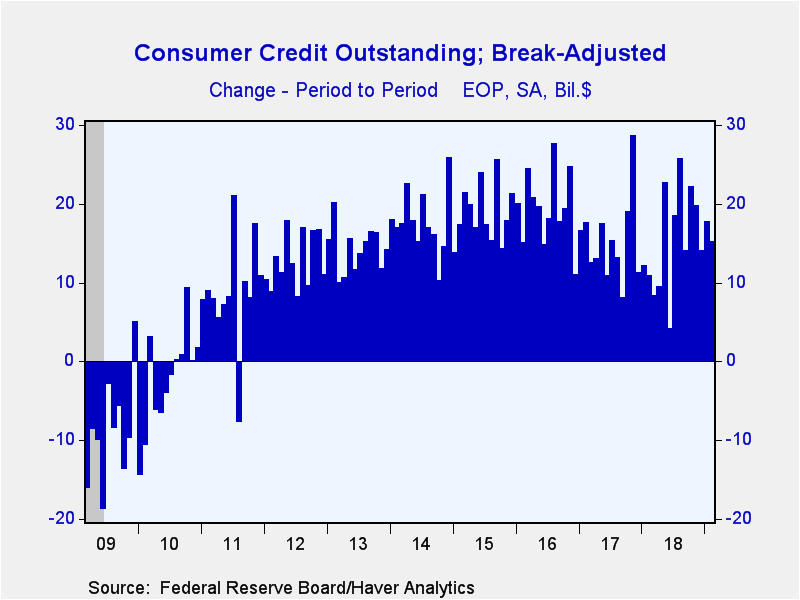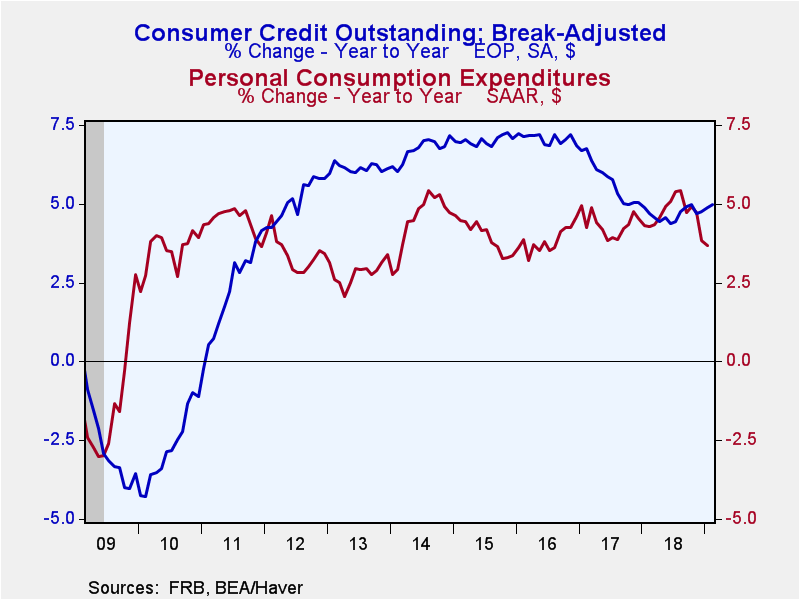 Global| Apr 05 2019
Global| Apr 05 2019U.S. Consumer Credit Slows
Summary
Consumer credit outstanding increased $15.18 billion (5.0% year-on-year) to $4.046 trillion during February, following an upwardly revised $17.72 bil. in January (was $17.04 bil.). A $17.5 billion gain had been expected in the Action [...]
Consumer credit outstanding increased $15.18 billion (5.0% year-on-year) to $4.046 trillion during February, following an upwardly revised $17.72 bil. in January (was $17.04 bil.). A $17.5 billion gain had been expected in the Action Economics Forecast Survey.
Nonrevolving credit usage increased $12.24 billion (5.5% y/y) during February, down from $15.1 bil. in January. Borrowing from the federal government, which issues roughly 40% of nonrevolving credit, grew 7.7% y/y. Depository institutions (30% of credit) gained 4.2% y/y. Meanwhile finance company balances edged down 0.6% y/y and credit union loans jumped 13.1% y/y. Both of these sectors provide about 15% of nonrevolving credit respectively.
Revolving consumer credit balances grew $2.95 billion (3.5% y/y) in February, a bit more than January’s $2.6 bil. reading . Credit provided by depository institutions, which makes up 90% of revolving balances, grew 5.4% y/y. Borrowing from credit unions (6% of the issuance) was up 7.4% y/y.
During Q4'18, student loan debt increased 5.3% y/y, the same as Q3, but down significantly from the 14.7% y/y growth in 2008. Motor vehicle financing grew 3.6% y/y.
These Federal Reserve Board figures are break-adjusted and calculated by Haver Analytics. The breaks in the series in 2005, 2010 and 2015 are the result of the incorporation of the Census and Survey of Finance Companies, as well as changes in the seasonal adjustment methodology.
The consumer credit data are available in Haver's USECON database. The Action Economics figures are contained in the AS1REPNA database.
| Consumer Credit Outstanding (M/M Chg, SA) | Feb | Jan | Dec | Feb y/y | 2018 | 2017 | 2016 |
|---|---|---|---|---|---|---|---|
| Total | $15.18 bil. | $17.72 bil. | $14.13 bil. | 5.0 | 4.8 | 5.0 | 6.8 |
| Nonrevolving | 12.24 | 15.11 | 12.96 | 5.5 | 5.4 | 4.8 | 6.9 |
| Revolving | 2.95 | 2.62 | 1.17 | 3.5 | 3.1 | 5.6 | 6.8 |
Gerald D. Cohen
AuthorMore in Author Profile »Gerald Cohen provides strategic vision and leadership of the translational economic research and policy initiatives at the Kenan Institute of Private Enterprise.
He has worked in both the public and private sectors focusing on the intersection between financial markets and economic fundamentals. He was a Senior Economist at Haver Analytics from January 2019 to February 2021. During the Obama Administration Gerald was Deputy Assistant Secretary for Macroeconomic Analysis at the U.S. Department of Treasury where he helped formulate and evaluate the impact of policy proposals on the U.S. economy. Prior to Treasury, he co-managed a global macro fund at Ziff Brothers Investments.
Gerald holds a bachelor’s of science from the Massachusetts Institute of Technology and a Ph.D. in Economics from Harvard University and is a contributing author to 30-Second Money as well as a co-author of Political Cycles and the Macroeconomy.









